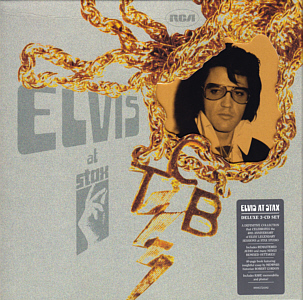|
If there was an inherent flaw in the marketing
and presentation of Elvis’ music during the ‘70s, it was undoubtedly
the lack of visual distinction between his live and studio output.
By the time Elvis’ last album featuring recordings from the Stax
sessions was issued in January 1975, no fewer than 20 albums had
been issued by RCA that featured Elvis on stage wearing a jumpsuit.
This repetitious process, regulated by Elvis’ manager, Colonel Tom
Parker, undeniably abetted a lack of clear focus on Elvis’
studio-recorded repertoire, and the presentation of his Stax tracks
between 1973 and 1975 was no exception.
During the first few months of 1973 all seemed well when Elvis,
after signing a lucrative new seven-year contract in March,
subsequently hit the coveted #1 spot with the live album Aloha From
Hawaii Via Satellite in May. However, within months, the creative
thinking went rapidly downhill as RCA, eager to ride on Elvis’
renewed chart-topping status and recoup its financial outlay,
cobbled together a July album release that consisted mainly of
session leftovers. Imaginatively called Elvis and housed in a sleeve
that featured an obligatory live-on-stage shot, it only managed to
reach #52 in the album chart.
In the same month, Elvis received polite notification from RCA of
his new contractual obligation. Amongst other things, it advised
that a recording session needed to take place in the month of July
at a studio of Elvis’ choosing. With some haste, the legendary Stax
Studio complex on McLemore Avenue in Memphis was booked for four
nights. Disappointingly, only nine songs were completed over this
period due to technical issues with the studio andElvis’
acknowledged disenchantment with several of the new compositions
submitted. Despite this, two songs were considered strong enough for
A-sidesingle release: Mark James’ “Raised On Rock” and Tony Joe
White’s “I’ve Got A Thing About You Baby.” At Elvis’ behest, the
latter, arguably the strongest track, was held back until 1974 for a
future single.
Despite the setback, RCA’s sales objectives required an October
album and this need took precedent over any musical coherence. With
Colonel Tom Parker’s agreement, it scheduled an album called Raised
On Rock/For Ol’ Times Sake and it mirrored the fate of its
predecessor. Quickly assembled, it featured two songs previously
issued as a single the previous month, five finished Stax cuts and
three home recordings.
Elvis himself took the first steps to redemption of some sort. On
December the 10th he returned to Stax and embarked on a seven-day
recording spree that spawned 18 faultless performances; from the
jubilant “Talk About The Good Times” to the introspective “It’s
Midnight” and pure rock ’n’ roll of “Promised Land,” Elvis sang as
if his life depended on it. Regrettably, Elvis’ renewed vigor was
not matched by any innovative thinking by either his management or
RCA. The repertoire was consequently split over two albums, Good
Times in March 1974 and Promised Land in January 1975. Even during
this period, RCA issued the album Elvis Recorded Live On Stage In
Memphis in July 1974. To complete the overkill, Colonel Parker
issued an Elvis talking-only album called Having Fun With Elvis On
Stage on his own Boxcar label to sell directly at shows—and if that
was not enough, RCA reissued it in September for retail. In spite of
this muddled release schedule, it’s of great merit to Elvis that the
December sessions spawned three top 20 singles and a #1 country
album, Promised Land.
In defense of RCA, fiscally and commercially, it’s unlikely that any
other record company would have done things differently. His
management still pulled the creative strings and supplied the
photo(s) that had to be returned after use. In this regard, even
Elvis was somewhat complicit, as aside from the odd press photo call,
no off-stage photographic session was ever officially scheduled for
RCA in the‘70s.
Hindsight is a wonderful thing of course, but Elvis At Stax aims to
put things right.
Legacy Recordings is proud to present its 40th anniversary
celebration of the excellence Elvis strived for at Stax Studios. The
dissipation of the Stax recordings across three albums over 18
months provided little or no creative kudos for such deserving
artistic accomplishment. The objective of Elvis At Stax is to
reflect the true spontaneity and musicianship of Elvis’ sessions on
McLemore Avenue. Featuring many outtakes, remixes and studio banter,
it captures the very essence of Elvis the musician at work. Packaged
lavishly with insightful sleeve notes, historic artifacts and rare
photographs, it provides a testament to the unequaled career of
Elvis Presley. (Roger Semon, June 2013 / elvisthemusic.com) |
